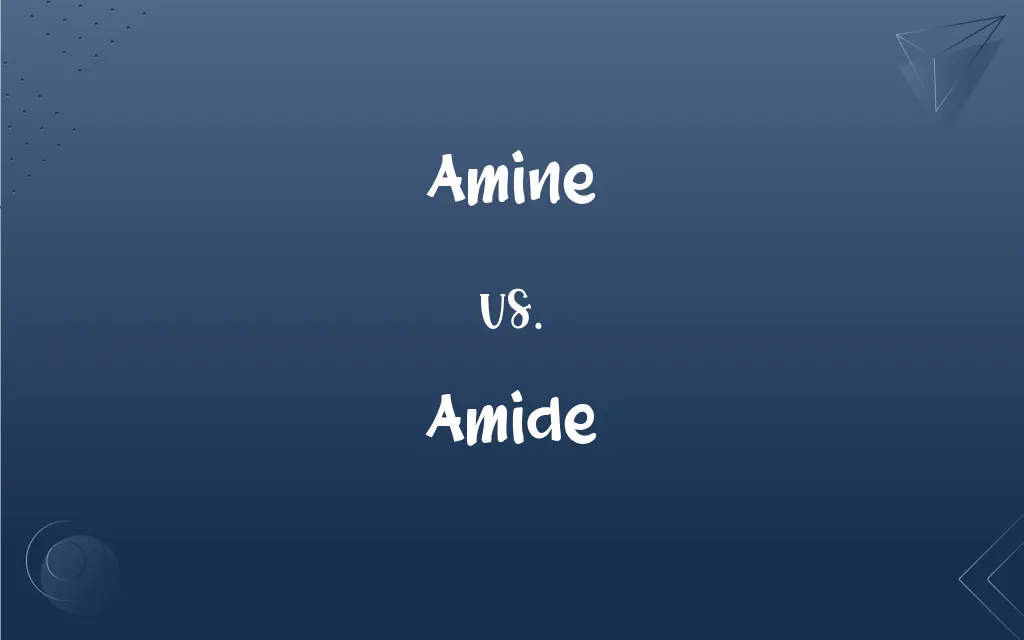Amine vs. Amide: What's the Difference?
Edited by Janet White || By Harlon Moss || Updated on October 20, 2023
Amine is an organic compound containing a nitrogen atom bonded to hydrogen atoms and/or alkyl groups, while amide contains a nitrogen atom bonded to a carbonyl carbon.

Key Differences
Amine refers to organic compounds and functional groups that contain a basic nitrogen atom with a lone pair of electrons. Amides, on the other hand, are a class of compounds that also contain a nitrogen atom, but this atom is connected to a carbonyl group (C=O).
Amines are derived from ammonia (NH3) where one or more hydrogen atoms have been replaced by a substituent such as an alkyl or aryl group. Amides have a structure in which the nitrogen atom is directly bonded to the carbonyl carbon of an acid.
In terms of reactivity, amines are generally basic and can react with acids to form salts. Amides are much less basic than amines due to the electron-withdrawing effect of the carbonyl group.
Amines are characterized by their fishy smell, especially the lower members of the series. Amides, however, do not typically have a strong odor and are often found in nature as components of proteins.
Amines can be primary, secondary, or tertiary based on how many alkyl or aryl groups are attached to the nitrogen. Amides can also be primary, secondary, or tertiary, but this classification is based on how many hydrogen atoms on the nitrogen have been replaced by alkyl or aryl groups.
ADVERTISEMENT
Comparison Chart
Basic Structure
Nitrogen atom bonded to hydrogen and/or alkyl groups
Nitrogen atom bonded to a carbonyl carbon
Derived From
Ammonia
Carboxylic acids
Reactivity
Basic, forms salts with acids
Less basic, affected by carbonyl group
Odor
Fishy smell
Generally odorless
Classification
Based on number of alkyl groups on nitrogen
Based on number of alkyl groups replacing hydrogen on N
ADVERTISEMENT
Amine and Amide Definitions
Amine
An organic compound derived from ammonia by replacement of one or more hydrogen atoms by organic groups.
Methylamine (CH3NH2) is a type of amine.
Amide
A functional group in organic chemistry consisting of a carbonyl group attached to nitrogen.
Ethyl acetamide is an amide with an ethyl group attached.
Amine
Nitrogen-containing organic compounds that can be considered as derived from ammonia.
Aniline, C6H5NH2, is an aromatic amine.
Amide
The product of a reaction between a carboxylic acid and an amine.
The reaction between formic acid and ammonia yields formamide, an amide.
Amine
A substance having the properties of an ammonia molecule but with one or more hydrogens substituted by a carbon-containing group.
Ethylamine is an amine with two carbons.
Amide
An organic compound that contains a carbonyl group (C=O) bonded to a nitrogen atom.
Benzamide is an aromatic amide.
Amine
A functional group in organic chemistry that consists of a nitrogen atom attached to hydrogen atoms or alkyl groups.
Trimethylamine (N(CH3)3) is a tertiary amine.
Amide
A compound formed from an acid and an amine.
Acetamide is an amide derived from acetic acid.
Amine
A basic compound with properties resembling ammonia, but in which hydrogen atoms are replaced by alkyl or aryl groups.
Butylamine is a primary amine with four carbon atoms.
Amide
An organic molecule derived from a carboxylic acid in which the -OH group is replaced by an -NH2 group.
Urea is an amide found in urine.
Amine
Any of a group of organic compounds of nitrogen, such as ethylamine, C2H5NH2, that may be considered ammonia derivatives in which one or more hydrogen atoms have been replaced by a hydrocarbon group.
Amide
An organic compound, such as acetamide, containing the CONH2 group.
Amine
(inorganic chemistry) A functional group formally derived from ammonia by replacing one, two or three hydrogen atoms with hydrocarbon or other radicals.
Amine
(organic chemistry) Any organic compound containing an amine functional group.
Amine
One of a class of basic substances derived from ammonia by replacement of one or more hydrogen atoms by an alkyl or aryl group. Compare amide, in which an acyl group is attached to the nitrogen. Hydroxylamine and hydrazine, which are not an organic compounds, are also basic and may also be considered amines.
Amine
A compound derived from ammonia by replacing hydrogen atoms by univalent hydrocarbon radicals
FAQs
What is an amide?
An amide is an organic compound formed from an acid and an amine with a carbonyl group bonded to a nitrogen atom.
What is an amine?
An amine is an organic compound derived from ammonia with hydrogen atoms replaced by alkyl or aryl groups.
Are amines acidic or basic?
Amines are generally basic.
How are tertiary amines identified?
Tertiary amines have three alkyl or aryl groups attached to the nitrogen.
What are the uses of amines?
Amines are used in making dyes, pharmaceuticals, and polymers.
What type of amine has two alkyl or aryl groups attached to nitrogen?
That would be a secondary amine.
How can you distinguish between an amine and amide?
An amine has a nitrogen bonded to hydrogen and/or alkyl groups, while an amide has a nitrogen bonded to a carbonyl carbon.
How can amines be synthesized?
Amines can be synthesized by reducing nitriles, amides, or nitro compounds.
What role does the carbonyl group play in the reactivity of amides?
The carbonyl group in amides makes them less basic and less reactive than amines.
How are amides typically formed?
Amides are formed by the reaction of carboxylic acids and amines.
Are amides typically reactive?
Amides are generally less reactive than amines due to the electron-withdrawing effect of the carbonyl group.
Do amines have higher boiling points than alkanes?
Yes, amines have higher boiling points due to hydrogen bonding.
What are some common examples of amines and amides in everyday life?
Examples include the amine in amino acids and proteins, and the amide in nylon and other polymers.
Can amines act as nucleophiles?
Yes, amines can act as nucleophiles due to the lone pair on the nitrogen atom.
What is the general formula for a primary amide?
The general formula for a primary amide is RCONH2.
Do amides have a strong smell like amines?
No, amides generally do not have a strong odor unlike some amines.
Are amines soluble in water?
Lower amines are soluble in water due to hydrogen bonding, but solubility decreases with increased chain length.
What is the significance of amides in biology?
Amides are key components in proteins as peptide bonds.
Can amides be hydrolyzed?
Yes, amides can be hydrolyzed to produce carboxylic acids and amines.
How are amides named in IUPAC nomenclature?
Amides are named by replacing the -oic acid or -ic acid suffix of the parent acid with -amide.
About Author
Written by
Harlon MossHarlon is a seasoned quality moderator and accomplished content writer for Difference Wiki. An alumnus of the prestigious University of California, he earned his degree in Computer Science. Leveraging his academic background, Harlon brings a meticulous and informed perspective to his work, ensuring content accuracy and excellence.
Edited by
Janet WhiteJanet White has been an esteemed writer and blogger for Difference Wiki. Holding a Master's degree in Science and Medical Journalism from the prestigious Boston University, she has consistently demonstrated her expertise and passion for her field. When she's not immersed in her work, Janet relishes her time exercising, delving into a good book, and cherishing moments with friends and family.































































